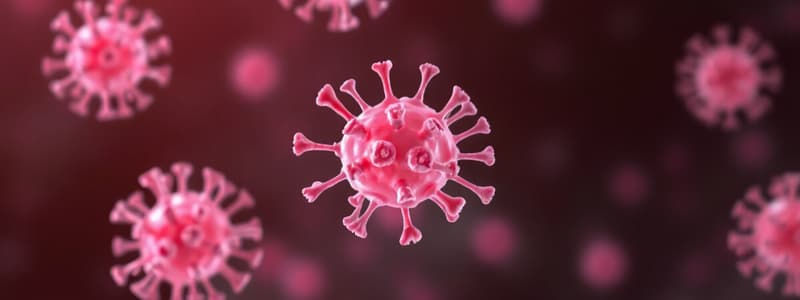Podcast
Questions and Answers
What are the general features of autoimmune diseases?
What are the general features of autoimmune diseases?
Autoimmune diseases are chronic, often progressive, have overlapping clinical manifestations, and may target either cellular or organ-specific self-antigens.
Name two examples of organ-specific autoimmune diseases and their affected organs.
Name two examples of organ-specific autoimmune diseases and their affected organs.
Grave's disease affects the thyroid gland and Type 1 Diabetes Mellitus affects the pancreas.
How do systemic autoimmune diseases differ from organ-specific autoimmune diseases?
How do systemic autoimmune diseases differ from organ-specific autoimmune diseases?
Systemic autoimmune diseases affect multiple organs and systems throughout the body, while organ-specific diseases target a specific organ.
What factors can influence the signs and symptoms of autoimmune diseases?
What factors can influence the signs and symptoms of autoimmune diseases?
Describe the impact of autoreceptor antibodies in autoimmune diseases, giving an example.
Describe the impact of autoreceptor antibodies in autoimmune diseases, giving an example.
What is a common feature of the immune responses in autoimmune diseases?
What is a common feature of the immune responses in autoimmune diseases?
Why is classification of autoimmune diseases often difficult?
Why is classification of autoimmune diseases often difficult?
What happens to individuals with multiple autoimmune diseases?
What happens to individuals with multiple autoimmune diseases?
Give an example of a Type II hypersensitivity reaction in autoimmune disease.
Give an example of a Type II hypersensitivity reaction in autoimmune disease.
List two systemic autoimmune diseases and their potential symptoms.
List two systemic autoimmune diseases and their potential symptoms.
What is immunologic tolerance and why is it important for maintaining health?
What is immunologic tolerance and why is it important for maintaining health?
Explain the difference between central tolerance and peripheral tolerance.
Explain the difference between central tolerance and peripheral tolerance.
Describe the role of anergy in peripheral tolerance.
Describe the role of anergy in peripheral tolerance.
What is the role of costimulatory molecules on antigen-presenting cells in T cell activation?
What is the role of costimulatory molecules on antigen-presenting cells in T cell activation?
What mechanisms contribute to the suppression of autoreactive lymphocytes by regulatory T cells?
What mechanisms contribute to the suppression of autoreactive lymphocytes by regulatory T cells?
How does molecular mimicry contribute to autoimmune diseases?
How does molecular mimicry contribute to autoimmune diseases?
How does antigen sequestration contribute to immunologic tolerance?
How does antigen sequestration contribute to immunologic tolerance?
What is the significance of the HLA-B27 allele in autoimmune diseases?
What is the significance of the HLA-B27 allele in autoimmune diseases?
Identify key factors that can lead to the breakdown of self-tolerance.
Identify key factors that can lead to the breakdown of self-tolerance.
What are the potential outcomes of the failure of self-tolerance?
What are the potential outcomes of the failure of self-tolerance?
Describe the effect of viral infections on the development of autoimmune diseases.
Describe the effect of viral infections on the development of autoimmune diseases.
Explain how traumatic injury can lead to autoimmune reactions.
Explain how traumatic injury can lead to autoimmune reactions.
What mechanisms lead to the release of sequestered self-antigens?
What mechanisms lead to the release of sequestered self-antigens?
What is polyclonal B cell activation and its relevance to autoimmunity?
What is polyclonal B cell activation and its relevance to autoimmunity?
Discuss the interplay between genetic and environmental factors in the development of autoimmunity.
Discuss the interplay between genetic and environmental factors in the development of autoimmunity.
What is the significance of mutation of apoptosis genes in the context of autoimmune lymphoproliferative disorders?
What is the significance of mutation of apoptosis genes in the context of autoimmune lymphoproliferative disorders?
Explain the importance of genetic factors in autoimmune diseases.
Explain the importance of genetic factors in autoimmune diseases.
What role do defective regulatory T cells play in autoimmunity?
What role do defective regulatory T cells play in autoimmunity?
How does inflammatory destruction expose cryptic epitopes?
How does inflammatory destruction expose cryptic epitopes?
What is the relationship between antibody reactions to streptococcal proteins and myocarditis?
What is the relationship between antibody reactions to streptococcal proteins and myocarditis?
Flashcards
Immunologic Tolerance
Immunologic Tolerance
The immune system's ability to distinguish between self and non-self antigens, preventing attacks on the body's own cells and tissues.
Self-tolerance
Self-tolerance
A specific type of immunologic tolerance where the immune system does not react against the individual's own antigens.
Central Tolerance
Central Tolerance
The process of eliminating or inactivating autoreactive lymphocytes (T and B cells) within the thymus or bone marrow, preventing them from reaching the periphery.
Anergy
Anergy
Signup and view all the flashcards
Antigen Sequestration
Antigen Sequestration
Signup and view all the flashcards
Autoimmune Disease
Autoimmune Disease
Signup and view all the flashcards
Failure of Self-Tolerance
Failure of Self-Tolerance
Signup and view all the flashcards
Susceptibility Genes
Susceptibility Genes
Signup and view all the flashcards
Environmental Triggers
Environmental Triggers
Signup and view all the flashcards
Mechanisms of Autoimmunity
Mechanisms of Autoimmunity
Signup and view all the flashcards
T cell anergy breakdown
T cell anergy breakdown
Signup and view all the flashcards
T cell suppression in AIDS
T cell suppression in AIDS
Signup and view all the flashcards
Molecular mimicry
Molecular mimicry
Signup and view all the flashcards
Rheumatic heart disease
Rheumatic heart disease
Signup and view all the flashcards
Polyclonal B cell activation
Polyclonal B cell activation
Signup and view all the flashcards
Exposure of hidden self-antigens
Exposure of hidden self-antigens
Signup and view all the flashcards
Familial autoimmune disease
Familial autoimmune disease
Signup and view all the flashcards
HLA alleles and autoimmunity
HLA alleles and autoimmunity
Signup and view all the flashcards
Apoptotic pathway defects and autoimmunity
Apoptotic pathway defects and autoimmunity
Signup and view all the flashcards
Infection and autoimmunity
Infection and autoimmunity
Signup and view all the flashcards
Organ or Cell-Specific Autoimmunity
Organ or Cell-Specific Autoimmunity
Signup and view all the flashcards
Chronicity and Progressiveness in Autoimmune Diseases
Chronicity and Progressiveness in Autoimmune Diseases
Signup and view all the flashcards
Classification Challenges in Autoimmune Diseases
Classification Challenges in Autoimmune Diseases
Signup and view all the flashcards
Shared Symptoms Across Autoimmune Diseases
Shared Symptoms Across Autoimmune Diseases
Signup and view all the flashcards
Coexistence of Autoimmune Diseases
Coexistence of Autoimmune Diseases
Signup and view all the flashcards
External Factors Influencing Autoimmune Disease
External Factors Influencing Autoimmune Disease
Signup and view all the flashcards
Commonly Affected Organs in Autoimmune Diseases
Commonly Affected Organs in Autoimmune Diseases
Signup and view all the flashcards
Organ-Specific Autoimmune Diseases
Organ-Specific Autoimmune Diseases
Signup and view all the flashcards
Systemic Autoimmune Diseases
Systemic Autoimmune Diseases
Signup and view all the flashcards
Study Notes
Tolerance and Autoimmune Disorders
- Tolerance is the inability of the immune system to mount an immune response against a specific antigen.
- Self-tolerance is the lack of response to the body's own antigens, crucial for maintaining harmony between cells and tissues.
- Tolerance mechanisms are broadly categorized as central and peripheral tolerance.
Central Tolerance
- Clonal deletion (apoptosis) of autoreactive T and B lymphocytes occurs in the thymus (T cells) or bone marrow (B cells).
- Post-thymic tolerance, includes mechanisms where self-reacting T cells ignore self-antigens, those antigens being sequestered (hidden), or in cells unable to respond (anergic) or by immune regulation.
Peripheral Tolerance
- Mechanisms in the peripheral lymphoid organs (lymph nodes, spleen, mucosal lymphoid tissue) remove or deactivate autoreactive lymphocytes.
- Anergy: irreversible functional inactivation of lymphocytes.
- Suppression by regulatory T cells (inhibiting lymphocyte activation through cytokine secretion, e.g., IL-10).
- Deletion by apoptosis, mutation of apoptosis genes can lead to autoimmune disorders.
- Antigen sequestration: certain tissues have blood-tissue barriers that hide antigens from autoreactive lymphocytes.
- Traumatic injury can expose these antigens and lead to autoimmune disorders.
Autoimmune Diseases
- Autoimmune diseases result from a failure of tolerance, allowing immune responses against self-antigens.
- These responses arise from interactions between abnormal susceptibility genes and environmental triggers, mainly infections.
- Mechanisms of autoimmunity include failure of self-tolerance, genetic factors, and infectious factors.
Breakdown of Self-Tolerance
- Breakdown of T cell anergy: upregulation of costimulatory molecules on antigen-presenting cells (APCs) leading to T cell activation against self-antigens.
- Failure of T cell-mediated suppression (e.g., AIDS).
- Molecular mimicry: microbial antigens sharing amino acid sequences with self-antigens triggering immune response against both.
Role of Susceptibility Genes
- HLA alleles are associated with autoimmunity (e.g., HLA-B27 and ankylosing spondylitis, HLA association with type 1 diabetes).
- Defective regulatory T-cell development is linked to some autoimmune disorders.
- Autoimmune diseases frequently involve genetic susceptibility patterns rather than single mutations.
Role of Infection
- Microbial agents (especially viruses) can modify self-antigens, lead to cross-reactions with microbial epitopes causing immune responses against self-antigens.
- Microbial agents can induce necrosis and inflammation, potentially up-regulating co-stimulatory molecules and releasing hidden antigens.
- Polyclonal activation of lymphocytes by microbial products can also contribute to autoimmune disorders.
Tissue Damage in Autoimmune Diseases
- Tissue damage can result from type II (antibody-mediated) hypersensitivity reactions (e.g., autoimmune hemolytic anemia), Type III (immune complex deposition) hypersensitivity such as Systemic Lupus Erythematosus and Rheumatoid Arthritis, and anti-receptor antibodies (e.g., Myasthenia gravis).
General Features of Autoimmune Diseases
- Immune responses target cellular or organ-specific self-antigens.
- Autoimmune diseases are chronic, progressive, with relapses and remissions, and overlapping features which leads to difficult classification.
- Similar symptoms can appear across various autoimmune diseases.
- Symptoms are influenced by factors such as age, hormones, and environmental factors.
Classification of Autoimmune Diseases
- Organ-specific autoimmune diseases (e.g., autoimmune thyroid disease [graves disease/Hashimoto], type 1 diabetes mellitus, myasthenia gravis).
- Systemic autoimmune diseases (e.g., Systemic lupus erythematosus, rheumatoid arthritis, inflammatory bowel disease).
Studying That Suits You
Use AI to generate personalized quizzes and flashcards to suit your learning preferences.




